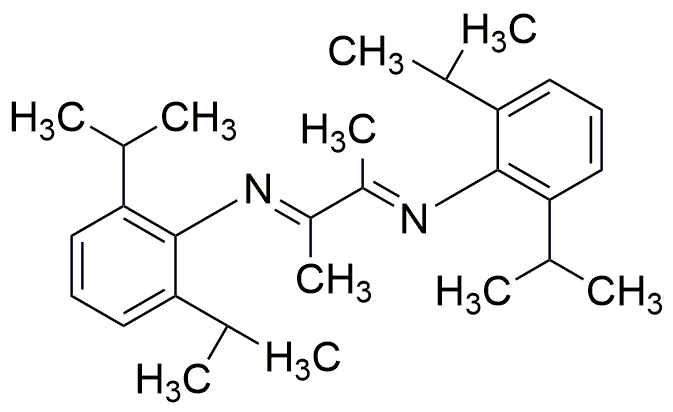2,3-Bis(2,6-diisopropylphenylimino)butane is widely utilized in research focused on:
- Catalysis: This compound serves as a ligand in various catalytic processes, enhancing reaction rates and selectivity in organic synthesis, particularly in the production of fine chemicals.
- Material Science: It is used in the development of advanced materials, including polymers and composites, where its unique properties can improve strength and thermal stability.
- Pharmaceutical Development: The compound plays a role in drug formulation, where its ability to form stable complexes can enhance the bioavailability of active pharmaceutical ingredients.
- Analytical Chemistry: It is employed as a reagent in analytical techniques, aiding in the detection and quantification of various substances, which is crucial for quality control in manufacturing.
- Environmental Applications: This chemical is explored in the remediation of pollutants, where it can facilitate the breakdown of harmful compounds, contributing to cleaner environments.
General Information
Properties
Safety and Regulations
Applications
2,3-Bis(2,6-diisopropylphenylimino)butane is widely utilized in research focused on:
- Catalysis: This compound serves as a ligand in various catalytic processes, enhancing reaction rates and selectivity in organic synthesis, particularly in the production of fine chemicals.
- Material Science: It is used in the development of advanced materials, including polymers and composites, where its unique properties can improve strength and thermal stability.
- Pharmaceutical Development: The compound plays a role in drug formulation, where its ability to form stable complexes can enhance the bioavailability of active pharmaceutical ingredients.
- Analytical Chemistry: It is employed as a reagent in analytical techniques, aiding in the detection and quantification of various substances, which is crucial for quality control in manufacturing.
- Environmental Applications: This chemical is explored in the remediation of pollutants, where it can facilitate the breakdown of harmful compounds, contributing to cleaner environments.
Documents
Safety Data Sheets (SDS)
The SDS provides comprehensive safety information on handling, storage, and disposal of the product.
Product Specification (PS)
The PS provides a comprehensive breakdown of the product’s properties, including chemical composition, physical state, purity, and storage requirements. It also details acceptable quality ranges and the product's intended applications.
Certificates of Analysis (COA)
Search for Certificates of Analysis (COA) by entering the products Lot Number. Lot and Batch Numbers can be found on a product’s label following the words ‘Lot’ or ‘Batch’.
Numéro de catalogue
Numéro de lot/série
Certificates Of Origin (COO)
This COO confirms the country where the product was manufactured, and also details the materials and components used in it and whether it is derived from natural, synthetic, or other specific sources. This certificate may be required for customs, trade, and regulatory compliance.
Numéro de catalogue
Numéro de lot/série
Safety Data Sheets (SDS)
The SDS provides comprehensive safety information on handling, storage, and disposal of the product.
DownloadProduct Specification (PS)
The PS provides a comprehensive breakdown of the product’s properties, including chemical composition, physical state, purity, and storage requirements. It also details acceptable quality ranges and the product's intended applications.
DownloadCertificates of Analysis (COA)
Search for Certificates of Analysis (COA) by entering the products Lot Number. Lot and Batch Numbers can be found on a product’s label following the words ‘Lot’ or ‘Batch’.
Numéro de catalogue
Numéro de lot/série
Certificates Of Origin (COO)
This COO confirms the country where the product was manufactured, and also details the materials and components used in it and whether it is derived from natural, synthetic, or other specific sources. This certificate may be required for customs, trade, and regulatory compliance.


